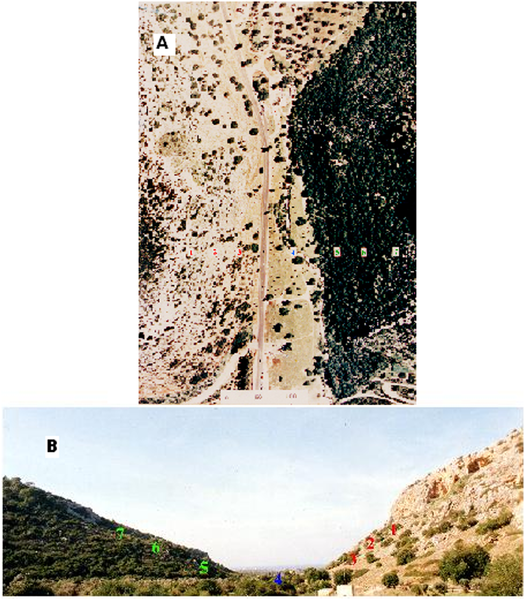Shmuel Raz and colleagues studied the communities of scorpions in a valley near Mount Carmel in Israel which has been dubbed "Evolution Canyon." Evolution Canyon" has steep slopes and runs approximately east-west, which means that the south-facing slope receive up to eight times as much solar radiation as the north-facing slope .
Thus, despite identical regional geology and rainfall, one slope, dubbed the "African" slope(AS) of the canyon is arid savannah-like while the "European slope(ES) boasts a lush, maquis-like forest environment separated by a narrow canyon floor that could easily be crossed by most animals and certainly would provide no barrier to a scorpion.
The AS is significantly warmer, less humid, more illuminated, and microclimatically more fluctuating than the opposite ES due to differences in geographic orientation

“Evolution Canyon”, Lower Nahal Oren, Mount Carmel, Israel. A.Aerial View, B. Cross section. The AS has three sampling stations - AS1, AS2, and AS3- at elevations 120 m, 90 m, and 60 m above sea level. The ES has three sampling stations as well - ES5, ES6, and ES7 - at 60 m, 90 m, and 120 m above sea level. From: Raz S, Retzkin S, Pavlíček T, Hoffman A, Kimchi H, et al. 2009 Scorpion Biodiversity and Interslope Divergence at “Evolution Canyon”, Lower Nahal Oren Microsite, Mt. Carmel, Israel. PLoS ONE 4(4): e5214. doi:10.1371/journal.pone.0005214
The researchers collected nearly 200 specimens of six different species of scorpions in "Evolution Canyon." While four of the species were found on both slopes of the canyon, two were only seen on the more arid, "African"-like slope. Similarly the "European" slope of the canyon yielded nearly a third fewer scorpion specimens than the "African" slope .
Despite the ease of movement between the two canyon faces, the particular adaptations of the scorpions to arid conditions have led to their greater abundance on the south-facing, "African" slope.
Differences in the diversity of species between the north and south facing slopes of "Evolution Canyon" have been observed in other groups of bacteria, fungi, plants and animals and in combination with these, new studies on scorpions show that the environmental pressures brought about by factors such as the amount of sunshine, temperature and drought whether individually or in combination, can act very locally to produce global changes in biodiversity.
Citation: Raz S, Retzkin S, Pavlı´cˇek T, Hoffman A, Kimchi H, et al. (2009) Scorpion Biodiversity and Interslope Divergence at ''Evolution Canyon'', Lower Nahal Oren Microsite, Mt. Carmel, Israel. PLoS ONE 4(4): e5214. doi:10.1371/journal.pone.0005214





Comments